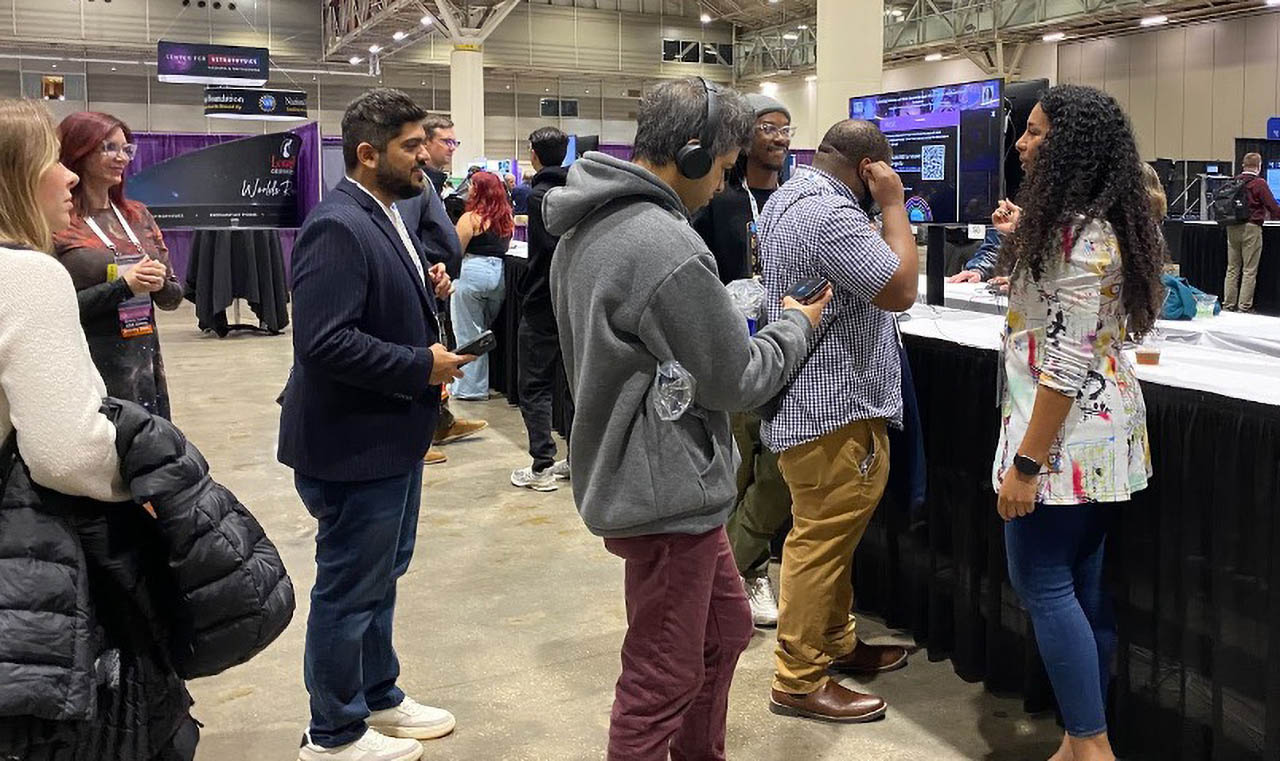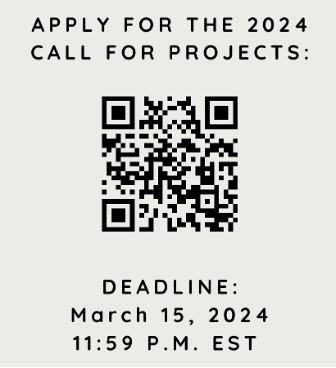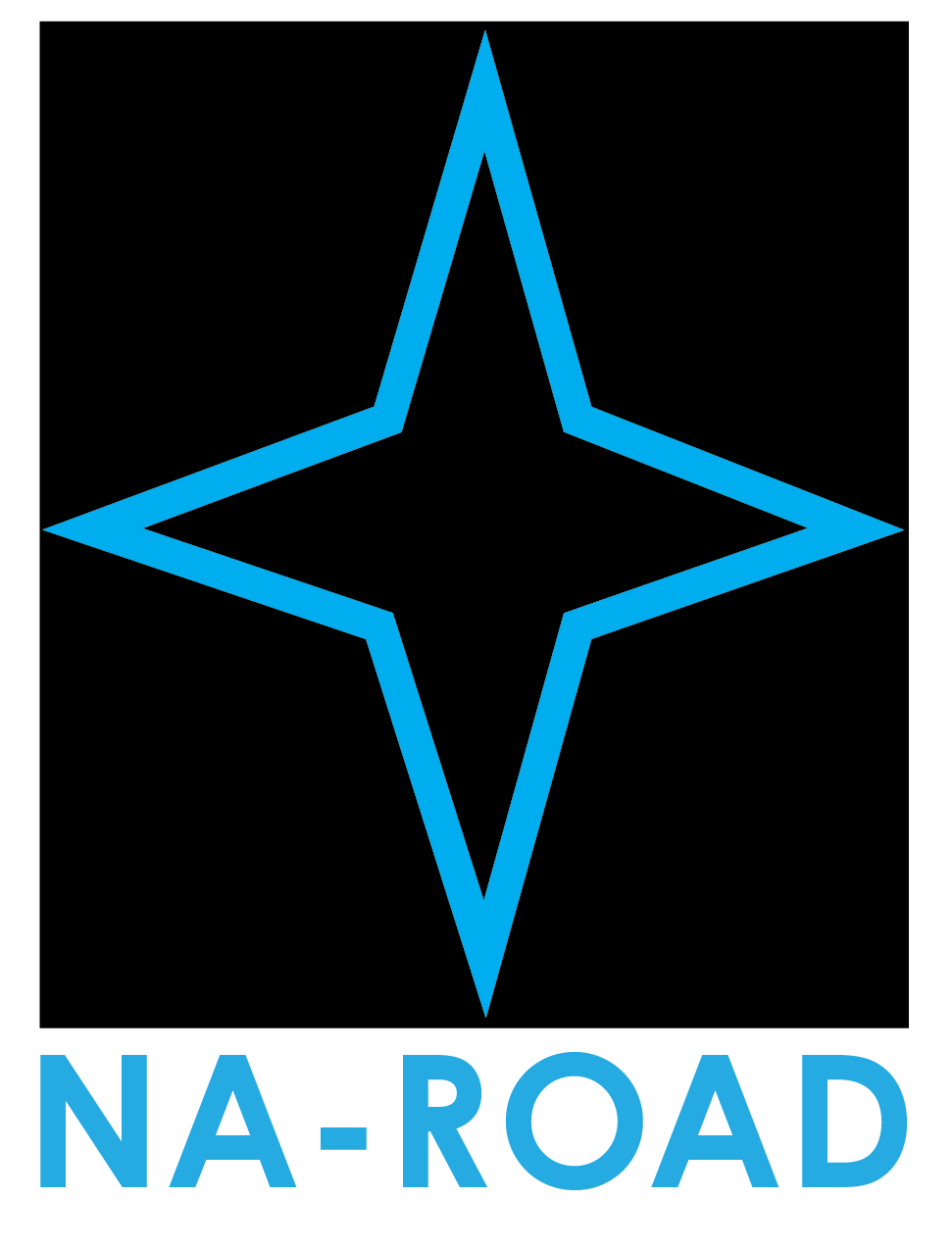The WGAP team at the conclusion of the Theater presentation. From left to right: Karla Sofia Garcia, Thara Caba, Liliana Rivera, Shaniya Jarrett, Kriscia Ramkissoon, Ava Polzin, Debra Elmegreen, and Yasmin Catricheo. Credit: IAU/NA-ROAD/S. Lifson
By Karla Sofia Garcia
The Women and Girls in Astronomy Program’s participation at the American Astronomical Society’s 243rd meeting at the New Orleans Ernest N. Morial Convention Center was a grand success! From a theater presentation filled to the brim to a poster presentation which brought on interest in the 2024 Call for Projects to participation in a Special Session Panel Discussion, the Women and Girls in Astronomy Program (WGAP) team had a week full of sharing the passion for astronomy for development and connecting with like-minded scholars, scientists, community leaders, and students.
The theater presentation introduced the WGAP as a joint initiative of the International Astronomical Union (IAU), Adler Planetarium and Science Museum, Associated Universities Inc (AUI), and Association of Universities for Research in Astronomy (AURA), all of which compose the North American Regional Office of Astronomy for Development (NA-ROAD). Yasmin Catricheo, Senior STEM Educator Specialist at AUI, highlighted that “astronomy for development is not about the stars, it’s about people”, and described the mission of the NA-ROAD.
Karla Sofia Garcia, WGAP Program Coordinator, shared statistics for the past 2023 WGAP cycle, including the large age range spanning from 3 years old to 56 years old, the geographical span of the WGAP throughout North America (Figure 2) and the total participants reached at 508, without counting those who indirectly benefited from the WGAP projects through videos and workshops published online. Garcia emphasized that anyone can initiate a WGAP project, from aspiring astronomers, to professionals and enthusiasts alike, and invited participants to apply for the 2024 Call for Projects, available in English, Spanish, and French.

Map with locations of the 10 WGAP projects of the 2023 cycle. Credit: IAU/NA-ROAD/K.S. Garcia
Five out of ten project leads were present at the 243rd AAS, and presented on their projects outcomes and successes. Shaniya Jarrett led the Astrobeats: Sounds of the Cosmos project, which empowered young black girls from Tennessee to explore astronomy through music. This project involved converting NASA data into compositions using data sonification software, allowing self-expression and fostering interest in science. “Witnessing the awe on people’s faces as they listened to music crafted from Astronomy data by middle school girls, was undoubtedly a highlight of my conference experience”, said Jarrett, about attending the AAS meeting with the WGAP team. In addition to the theater presentation, Jarrett presented a poster highlighting the WGAP Astrobeats project, titled Harmonizing Astronomy and Music: Empowering Black Girls through the AstroBeats Project, as a part of Session 172 – Empowering Minorities and Supporting Diversity. This poster presentation was interactive, with headphones available to listen in on the musical creations of the Astrobeats girls, which are publicly available on Youtube.

Interested attendees listen to the Astrobeats astronomical-musical compositions as Jarett garners a crowd. Credit: IAU/NA-ROAD/K.S. Garcia
Kriscia Ramkissoon led the Binoculars: Stepping stone to eyes on the skies project. This project in Trinidad and Tobago aimed to empower girls in children’s homes, by introducing them to the wonders of astronomy using binoculars, providing a gateway to the heavens and scientific exploration. The project tugged at the heartstrings of the attendees, as Ramkissoon shared anecdotes of the children in awe when observing Jupiter with their binoculars, purchased and gifted to these homes through the WGAP grant. In learning about the possibility of space travel, the young girls remarked on their future plans: “I will need a helmet on the moon if there is no air to breathe there!” and “I want to go to the moon! I will need to carry my snacks and juices” said by 6 and 5 year old girls inspired by the wonders of space.
Thara Caba led the Month of Astronomy in the Dominican Republic project. This initiative introduced a month-long calendar of activities to familiarize women and girls in the Dominican Republic with astronomy, featuring topics presented by established women researchers to encourage more women to study physics and contribute to the field. In many ways, this AAS meeting allowed Caba to achieve new milestones in her career: “I had the opportunity to attend my first AAS meeting thanks to WGAP. I was surprised with how many people were interested and passionate about our projects and what we were able to accomplish in our communities.” Caba was also a part of the NA-ROAD’s Special Session, Astronomy for a Better World, in which she served as a panelist sharing her experiences with astronomy in the Dominican Republic and highlighted the impact of her WGAP project in a country where astronomy education is rarely available.

Thara Caba speaks at the Astronomy for a Better world panel. Credit: IAU/NA-ROAD/K.S. Garcia
Liliana Rivera led the Ellas y las Estrellas project based in the southern border of Texas.This bilingual project spotlighted Hispanic women in astronomy, bringing astronomy closer to those with limited access, engaging attendees through experiments, and inspiring younger generations, especially young girls, to actively participate in STEM activities. Rivera shared the story of a mother who traveled with her son from Mexico to Texas, crossing the border just to attend the event. This mother was interested in Astronomy but didn’t speak English, so when she saw the Ellas y las Estrellas event was accessible to both Spanish and English speaking audiences, she knew was going to be able to understand the material. The impacts and successes of bilingual and intergenerational learning were evident through Rivera’s project.
Finally, Ava Polzin led the VERGE: Virtual Events for Remote Gathering and Engagement project, tailored for Indigenous girls in Hawai‘i. This program provides culturally relevant astronomy education, featuring talks from professional astronomers and facilitating a cultural exchange between Native star knowledge and Western science. After being impacted by the Hawai‘i fires, Polzin realized that the VERGE students needed accessible forms of support and education after such a disaster, and the program was re-structured to offer in-school visits from professional astronomers as well as from a traditional navigator specializing Native Hawaiian astronomy and wayfinding. The girls also received educational astronomy materials ahead of time, providing them with resources to engage with and benefit from until they could return to school. One of these materials is the SIRIUS B pedagogical text Astronomy as a Field: A Guide for Aspiring Astrophysicists, which was printed and distributed for the first time through the WGAP grant.

The hardcover copy of Astronomy as a Field: A Guide for Aspiring Astrophysicists is seen displayed under the WGAP iPoster as Ramkissoon speaks about the Binoculars project. Credit: IAU/NA-ROAD/A. Vega
The president of the IAU, Debra Elmegreen, attended the theater presentation, and immediately after the presentation was completed, she greeted the WGAP team (image 1). Elmegreen said, “I was so moved by the stories of the projects that the women in WGAP presented at AAS243! From bringing binoculars to legally protected children’s homes in Trinidad, to bilingual stem activities at the Texas border, to a month of astronomy in the Dominican Republic, and so much more, these women are inspiring girls (and boys) to get excited about STEM through astronomy. They are wonderful role models and ambassadors for our field, and I’m so proud of them and grateful for their efforts.”
The WGAP serves as an exemplary project, with which a better future facilitated through astronomy can be envisioned.

The growing crowd at the WGAP AAS Poster. Credit: IAU/NA-ROAD/A. Vega
The iPoster presentation, Empowering a Network of Today’s Leaders: The Women and Girls in Astronomy Program, presented by lead author Karla Sofia Garcia, was a part of Session 201 – Community and Profession and included five sections which detailed key aspects of the Women and Girls in Astronomy Program’s founding, goals, first cycle, takeaways, and future developments. Garcia highlighted the diversity of possibilities for projects under the astronomy for development umbrella; the sky is truly the limit in terms of what WGAP projects can do and achieve. The five project leads were available to present on and answer questions about their specific projects to a crowd of interested and curious conference attendees. Rivera spoke to the experience of presenting on such a unique and impactful program as the Women and Girls in Astronomy Program at the AAS and how it was received: “It was truly rewarding to see how other AAS attendees appreciated the effort and time invested in our WGAP projects. It motivates me to continue.”
Learn more about applying for a 2024 WGAP grant here.
Access the Google application form.

Scan the QR code to access the application for the 2024 cycle of the Women and Girls in Astronomy Program!


